How does nature inspire technology and engineering?& We find out how bamboo may make effective wind turbines, and how the material that makes up locust tendons could soon be in your shoes and electronics!
In this episode
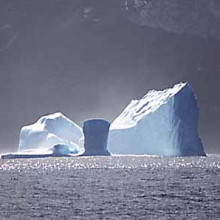
Freeze on oil
American researchers have discovered that the Arctic Circle may contain as much as 30% of the world's undiscovered natural gas deposits and upto 13% of undiscovered oil, or double what we first thought. Writing in the journal Science, US Geological Survey (USGS) scientist Donald Gautier and his colleagues have used geological data, including information provided by petroleum companies, to make predictions about the locations and quantities of oil and gas reserves north of the Arctic Circle.
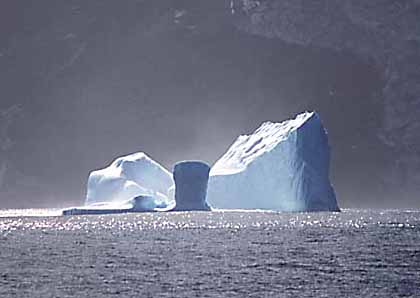 They began by first geologically dividing up the area, which covers 6% of the planet's surface, and singling out 49 hotspot regions termed assessment units (AUs). These were areas that contained the appropriate types of sedimentary rocks more than 3km thick, the minimum rock depth thought to be required to bury petroleum-bearing source rocks sufficiently to produce oil. Onto this map the team then superimposed data about the source rock types, migration pathways and other geological configurations that alter the prospects of finding oil in a given location. They then compared these findings with similar results compiled from 246 other oil-bearing locations worldwide in order to make predictions about the chances of each of the Arctic areas containing appreciable reserves.
They began by first geologically dividing up the area, which covers 6% of the planet's surface, and singling out 49 hotspot regions termed assessment units (AUs). These were areas that contained the appropriate types of sedimentary rocks more than 3km thick, the minimum rock depth thought to be required to bury petroleum-bearing source rocks sufficiently to produce oil. Onto this map the team then superimposed data about the source rock types, migration pathways and other geological configurations that alter the prospects of finding oil in a given location. They then compared these findings with similar results compiled from 246 other oil-bearing locations worldwide in order to make predictions about the chances of each of the Arctic areas containing appreciable reserves.
The results suggest that between 22 billion and 256 billion barrels of oil lie undiscovered underneath the Arctic, which is more than double what's previously been discovered there and might account for up to 4% of the world's remaining oil and 13% of the remaining undiscovered oil. To put these numbers into perspective, current estimates suggest that the World burns 30 billion barrels of oil per year and there are about 1240 billion barrels remaining globally. At worst, the Arctic could probably sate the populations thirst for oil for at least one year.
As well as oil the models also predict prodigious natural gas deposits at least three times greater in energy terms than the oil reserves. Most of this gas is in Russian territory which, say the researchers, could "reinforce the preeminent strategic resource position of that country," if they exploit it. Either way, tough decisions need to be taken regarding the recovery of Arctic oil given the environmental costs, both of obtaining it and when it is burned.
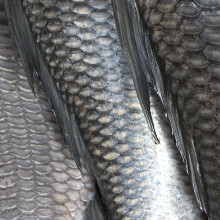
Fatty acids affect genes
We hear a lot about good fats and bad fats, and it can all get a bit confusing. Now researchers in the US have studied the effects off the ratio of different fats in humans, and their effects on gene activity.
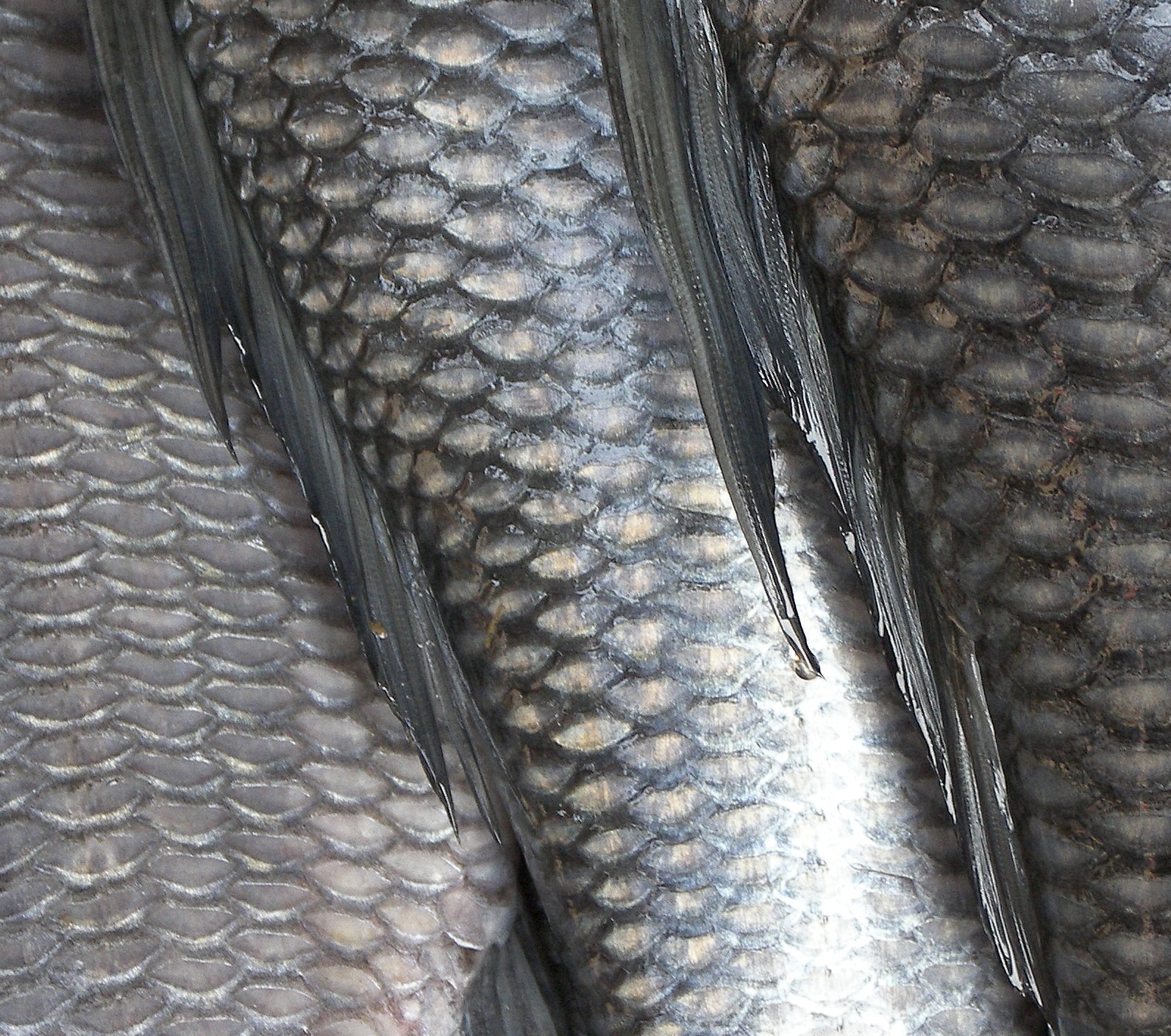 Over the past century, we've seen significant changes in our Western diet, including a shift in the ratio of certain fats, as omega 6 and omega 3 fatty acids. Omega 6 fats are usually found in meat and vegetable oils, while omega 3 come from flax and fish oils. Many researchers have suggested that this shift in fat ratios is contributing to bad effects on human health, including inflammation, which is a key player in autoimmune diseases and allergies, and even conditions such as diabetes and arthritis.
Over the past century, we've seen significant changes in our Western diet, including a shift in the ratio of certain fats, as omega 6 and omega 3 fatty acids. Omega 6 fats are usually found in meat and vegetable oils, while omega 3 come from flax and fish oils. Many researchers have suggested that this shift in fat ratios is contributing to bad effects on human health, including inflammation, which is a key player in autoimmune diseases and allergies, and even conditions such as diabetes and arthritis.
Now researchers led by Floyd Chilton, writing in the Journal of Biological Chemistry, have carried out a study using human volunteers on a controlled diet, to try and understand how changes in this fat ratio might affect our bodies.
Evidence from history suggests that our ancestors lived on a 2 to 1 ratio of omega 6 to omega 3 fats, but in recent years our Western diet has a ratio of around 10 to 1. The researchers took 27 healthy volunteers, and fed them on a controlled diet containing a 2 to 1 ratio of omega 6 to omega 3 fats, then measured the activity of certain genes and markers of inflammation and immune actitivity. The team found a significant drop in the levels of important molecules involved in inflammation, including an important inflammation protein called PI3K, which plays a crucial early role in inflammation.
Although this is only a very small study, and much more work needs to be done, the results are a tantalising suggestion of how the ratio of fats we eat could be affecting our gene activity, and increasing our risk of inflammation and other diseases. So watch this space.

The oldest known leper
This week scientists have uncovered what they think is the world's oldest example of a leprosy victim. This is a paper in the journal PLoS One and the pictures are absolutely stunning; to an osteoarchaeologist at least.
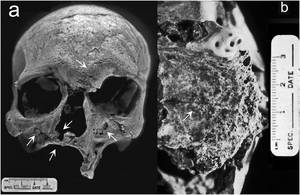 Gwen Robins and her colleagues, based at the Appalachian State University in North Carolina, have been working at a site in North-West India called Balathal.They have excavated a site which can be very quite reliably dated to about 2000BC, so 4000 years ago. There they've found the remains of a 37 year-old man, identified by looking at the shape of the pelvic bones, because men have different-shaped pelves to women.
Gwen Robins and her colleagues, based at the Appalachian State University in North Carolina, have been working at a site in North-West India called Balathal.They have excavated a site which can be very quite reliably dated to about 2000BC, so 4000 years ago. There they've found the remains of a 37 year-old man, identified by looking at the shape of the pelvic bones, because men have different-shaped pelves to women.
This skeleton shows bone changes which are very characteristic of leprosy. If you look at the skull you can see what's called reactive flare on the surface coating of the bone above one of the eye sockets. There's also a complete hole in the bone adjacent to the underside of the nose and there's also damage under one of the eye sockets and degeneration in the backbone.
For a long time people have said that there are a number of diseases that will cause similar bony changes like these: syphilis is one of them, osteomyelitis and tuberculosis are others. The reason this seems a good candidate for leprosy is because a) we can place it in space and time and b) it coincides with what we know people were doing at that time. There are historical records that go back to within 500 years of this: these are Sanskrit hymns which talk about an apparently similar disease. But until now there hasn't been any archaeological evidence to back it up.
It also coincides with what we know people were doing at this time. One theory suggests leprosy originated originally in Africa and as people migrated out of East Africa perhaps they took it with them. Another theory suggests it didn't originate there at all and that it could have originated where this person was found, in India. This body is a really important discovery because it coincides with early populations moving from nomadic hunter-gatherers to villages and towns supported by agriculture and keeping animals. They were therefore living more closely together and facilitating the spread of the disease. Leprosy is very low-infectivity but it is nonetheless an infectious illness. It needs people to be in close contact because only a small minority of the population are susceptible. You need a big population living together to get enough people spreading it around otherwise it would just die out.
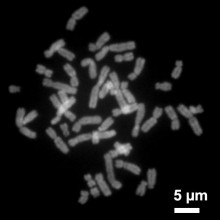
Cutting chromosomes gives clues to cell division
When we need new cells in our body, for example, to replace dead or damaged cells, they don't just appear from nowhere - they are created by the division of one cell into two new daughters. This process is called mitosis. Now scientists at the University of Michigan have used a clever laser technique to get an even closer insight into how mitosis works, and how it might go wrong in diseases like cancer, where cells divide out of control.
 Normally in mitosis, cells copy all their DNA, then line up these two sets of chromosomes in the middle of the cell, thanks to a microscopic scaffold-like structure called the spindle. The spindle grows from each side of the cell, and attaches to the chromosomes, eventually pulling them apart in opposite directions. If this goes wrong, then the new daughter cells may end up with the wrong number of chromosomes, which is bad news for the cell.
Normally in mitosis, cells copy all their DNA, then line up these two sets of chromosomes in the middle of the cell, thanks to a microscopic scaffold-like structure called the spindle. The spindle grows from each side of the cell, and attaches to the chromosomes, eventually pulling them apart in opposite directions. If this goes wrong, then the new daughter cells may end up with the wrong number of chromosomes, which is bad news for the cell.
For many years, researchers have tried to understand how the cell manages to divide its chromosomes equally between daughters, and now new research in this week's edition of Current Biology by Alan Hunt and his team may help to explain why. The Michigan team used high speed lasers to slice off tiny pieces of chromosomes from within living, dividing newt cells, and watched what happened. The pulses of laser light lasted for only a femtosecond -a billionth of a millionth of a second, but they were enough to cut the chromosomes.
Previously, researchers have though that something called 'polar ejection forces' are at working in dividing cells, helping to maintain the pull across the spindle, and ensure that an equal number of chromosomes go to each new cell. Hunt suspected that these forces should be directly related to the size of the chromosomes, so cutting off measurable pieces should have proportionally measurable effects on cell division - and that's what they found. They also discovered that these polar ejection forces are an important physical cue that helps to directly control mitosis, and the direction of chromosome movements.
Not only does this discovery shed light on cancer - and on chemotherapy, which often works by blocking mitosis in cancer cells - but it could also help us to understand genetic diseases such as Down's Syndrome, which are caused by an incorrect number of chromosomes during egg formation.
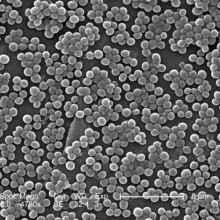
13:07 - A plethora of skin bacteria
A plethora of skin bacteria
with Dr Julie Seagre, National Human Genome Research Institute
Chris - Now also in the news this week, researchers have discovered a far more diverse collection of bacteria living on our skin than we thought was possible before, and it turns out that it's not just our good old friend Staph aureus, or other species of Staphylococcus that lay claim to our bodily surfaces. To tell us a bit more, here is Julie Segre, hello Julie...
Julie Segre - Hello.
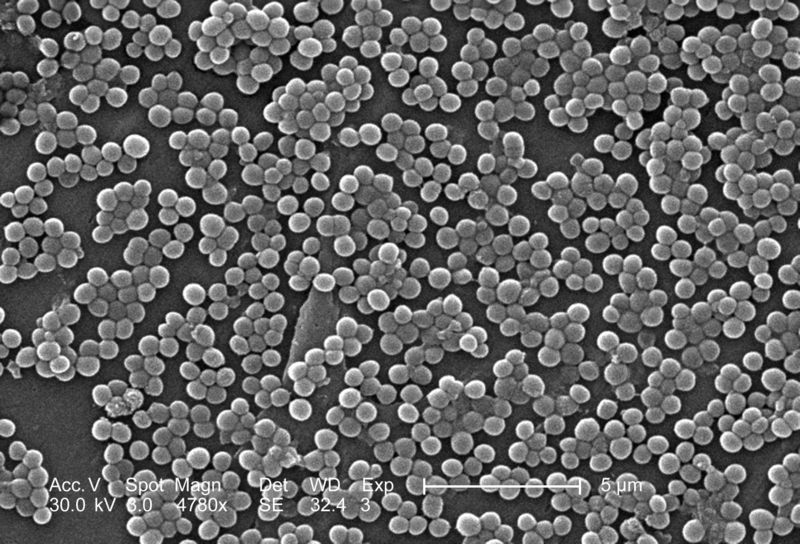 Chris - Welcome to the Naked Scientists. You've published this wonderful paper in Science this week about this, how did you go about mapping what bugs were living on who and where?
Chris - Welcome to the Naked Scientists. You've published this wonderful paper in Science this week about this, how did you go about mapping what bugs were living on who and where?
Julie Segre - Well it's really quite straightforward because the skin is so accessible, so we asked healthy volunteers to come in to the NIH clinical centre, and we took something that looks very much like a Q-tip and we swabbed the bacteria off the different parts of their body, everything from their forehead to behind their ear to behind their knees to underneath their foot and between their fingers, and then instead of culturing these in the lab, which has been our traditional method for knowing what bacteria reside on the skin, we sequenced the DNA immediately. So there was no culturing, we just looked at the signature of each bacteria by it's DNA sequence, and those sequences are unique enough that we could say 'this is a staphylococcus, this is a streptococcus, this is a Corynebacterium', and we found an enormous diversity of bacteria that we really hadn't appreciated before.
Chris - Because when you put things in culture, of course, there's a selection applied, in other words, some things won't grow in culture, so scientists will have missed them before, but by using genetic techniques, you're able to see what we couldn't see before. How are you then going to take that further, what can you tell us about the spectrum of bugs that are on the body's surface and how they might be linked to various diseases, for instance?
 Julie Segre - Well this is a baseline, and studied that were done previously that were based on culture really gave us an incomplete view. Now some of these bacteria, actually, now that we know we're looking for a Pseudomonas or we're now looking for a Corynebacterium, we can now culture them. And the interesting thing about culturing bacteria is it's very hard to know what you don't know, but it's easy to find what you are looking for. So now we tailor the media, for example a lot of the bacteria live on the oily surfaces of our skin, and when we add, we really just add lipids or oil to the culture broth, now we can grow these bacteria - we just didn't know they were there before. This gives us a baseline so now we can begin to examine eczema, psoriasis, acne, we can begin to ask what is different? Besides even what we can culture in the lab, how has the microflora changed, and then how do we have tailored therapies to being it back into balance?
Julie Segre - Well this is a baseline, and studied that were done previously that were based on culture really gave us an incomplete view. Now some of these bacteria, actually, now that we know we're looking for a Pseudomonas or we're now looking for a Corynebacterium, we can now culture them. And the interesting thing about culturing bacteria is it's very hard to know what you don't know, but it's easy to find what you are looking for. So now we tailor the media, for example a lot of the bacteria live on the oily surfaces of our skin, and when we add, we really just add lipids or oil to the culture broth, now we can grow these bacteria - we just didn't know they were there before. This gives us a baseline so now we can begin to examine eczema, psoriasis, acne, we can begin to ask what is different? Besides even what we can culture in the lab, how has the microflora changed, and then how do we have tailored therapies to being it back into balance?
Chris - Because some people have suggested that some of those skin conditions that you cite are aggravated by the presence of bacteria, and that in fact they drive or stimulate the condition and make it worse. It's not so much that it's just because there's damaged skin there, it's the combination of some damaged skin, which gets these bacteria in there in the first place, and then they make the problem worse.
Julie Segre - That's absolutely right. Something like eczema has a very strict connection with a Staphylococcus aureus infection. Then there are other diseases like the MRSA, the Methicillin-resistant Staph aureus, we know that's a bacterial infection, but we also know that a lot of people have a small, tiny, tiny amount of MRSA that you could find in their nose - they never get an infection. So we're suggesting that it might be the healthy bacteria, the commensals, that keep those pathogenic bacteria in check.
Chris - I was just going to say, because, we have come around to the idea in recent years that having a healthy intestinal bug spectrum helps to protect us from various things, if you go to a foreign country and you don't get travellers' diarrhoea because you have a healthy microbial flora, could the same be true of the skin, and in fact people in whom there is some kind of problem with their normal skin bacteria, it makes them more prone to getting infections that a person who doesn't have that problem with their skin flora wouldn't get?
Julie Segre - That's such an interesting idea to pursue, because its' interesting from the perspective of science, I think that's absolutely right on and that's where we're going to go with these experiments - to understand maybe why someone has a predilection for developing a skin disorder based on a change in their microflora. It's also interesting from a societal perspective - why is it that we want to eat prebiotics and balance our gut microflora, but we want to sterilise the outside of our bodies? We have to realise that there are healthy bacteria that live on our skin, and that we need to promote their growth. I'm not talking about letting everything grow on your skin, there are a lot of transient bacteria that are bad, and I'm a deep believer in personal hygiene - washing your hands, using soap and all sorts of products. I think there's a great use for all sorts of skincare products, but I also think that we have to realise that the goal is balance.
Chris - I was just going to say, Julie, have you been in the shower this month?! No, I'm just joking, but basically the way forward now is to begin to say how do we tie different bacterial populations to different diseases or lack of diseases, can we understand more about what's healthy. In the long run, perhaps we're going to see skin crèmes that are not designed to abolish bacteria, but to encourage the ones we do want, not the ones we don't.
Julie Segre - Absolutely, and I think there are also intrinsic changes to our skin, the skin of a baby is not the skin of a teenager, is not the skin of an older person, so we have to understand that these things change with time, and that as we change the environment in which we live, we may be altering the microflora. I think these are going to have profound effects on both common and rare skin disorders.
Chris - Julie, we're going to have to leave it there, thank you very much for joining us.
Julie Segre - Thank you so much.
Chris - That was Julie Seagre, who is from the National Human Genome Research Institute in the US, she's got a paper in Science this week in which she sets out basically what's living on you.
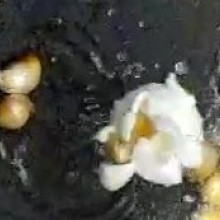
Steam explosions - the science of popcorn
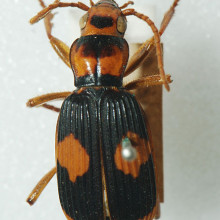
21:33 - Bombardier spray cans
Bombardier spray cans
with Andy McIntosh, University of Leeds
Chris - And it's not just popcorn that goes pop! Bombardier beetles are so-called because they quite literally bombard their predators with explosions from their rear-ends. They can actually expel boiling liquid over distances of a few feet. Now researchers have worked out how they do it and by copying their strategy they hope to build better aerosols and more efficient engines...one of the scientists doing that work is Andy McIntosh.
Andy - These insects, bombardier beetles, are found mainly in the hot parts of the world. Although I believe they have been discovered on the south coast of England. They can be as large as two centimetres but usually they're a bit smaller than that. They have in their backsides the most amazing combustion chamber, Chris, which is about one millimetre long or smaller. They mix two chemicals: hydroquinone and hydrogen peroxide. Even before they come into the chamber (and nobody quite knows why) they don't react in the very small tube that comes in. In the chamber there is a mixture now of catalysts: peroxidase and catalase. These cause the reaction to go much faster than it normally would which then heats up the water which is also there. It tries to expand but it can't initially expand and it can't vaporise therefore and boil properly until an exhaust valve, which is just a bit of cuticle - which won't really give way until there is a pressure rise sufficient to make it give way - when that goes then it basically suffers a vapour explosion. This all happens in 1/400th or even 1/500th of a second.
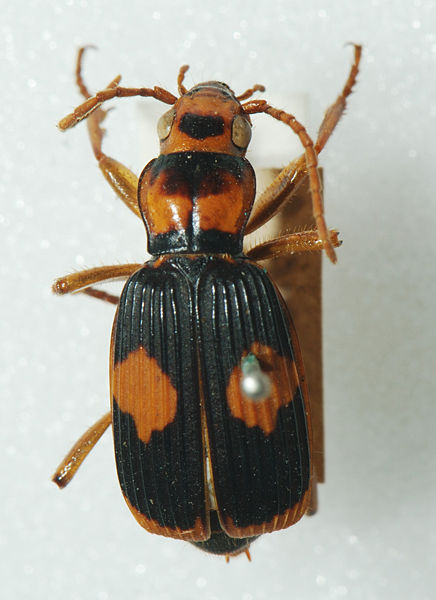 Chris - This is like you unscrewing the cap of a radiator of a car engine that's hot and the water still boiling as the pressure goes off. This is happening in the back end of this insect?
Chris - This is like you unscrewing the cap of a radiator of a car engine that's hot and the water still boiling as the pressure goes off. This is happening in the back end of this insect?
Andy - All the time when it's doing this, yes. It will do it for a few seconds. You're getting a huge number of blasts. If it goes on for ten seconds then obviously if it's doing it 400 times a second you can work out how many blasts it's doing.
Chris - Why would it do this?
Andy - Basically this beetle is being preyed on. Creatures like birds, spiders, ants are trying to get at this creature and they usually don't win. Very rarely a spider might be able to wrap it round in its web and eventually eat it but that's rare. They're usually stunned by this horrible mixture which is hot. Although they won't be killed by it they're be so stunned they won't be able to do anything for a few minutes and the beetle runs away.
Chris - It's an intriguing adaptation. It's amazing to think the beetle doesn't burn itself in the process. There must be some kind of adaptation that protects it. When you zoom in on the apparatus this beetle uses to do this what does that tell you about how it works?
Andy - As I mentioned earlier there is an exhaust valve that doesn't give way until there's a particular pressure. Also you should note that there is an inlet valve which is, as the explosion takes place there is an expansion which causes the whole chamber to begin to pinch the inlet valve. As it explodes that stops more stuff coming in. What we didn't realise was that there was an exhaust valve which was made out of a bit of a cuticle which would only stretch under a particular pressure. We reckon it's about 1.2 or 1.3 bars. We're not really quite sure. Nobody's been able to get an instrument small enough to measure it.
Chris - The one thing that strikes me, when you hear a story like this is there are so many applications for what amounts to a spray gun. Could you copy this?
Andy - Yes. Just be aware that people are already using this pulse combustion idea for engines. There is such a thing as a pulse combustor engine. And indeed it was used in the V1: the German's didn't realise that was the same was what was happening with the beetle. Without realising it people have been using this type of idea already. What is unique about this is that it gives a facility for, if we can copy it, for actually getting a spray of liquid and controlling the droplet sizes if we know how to get the valve system working properly. Rather than relying on a passive system which is what the beetle does we have introduced an active system whereby we control when the inlet of water comes in and the outlet of steam and water takes place. We're able to actually use the idea of the beetle, not on the chemistry but on the physics of this valve system, to actually get some very unique spray gun (as you call it) applications.
Chris - Engine have to atomise fuel to get the fuel into the cylinder quickly and in a very widely distributed and with a very uniform particle size. That means the burn would be better straight away.
Andy - Absolutely. That's one of our major interested areas that we're developing. We know that we can, without using a huge amount of pressure to atomise the fuel which is what usually happens. We know that we can do this with much lower pressures, albeit we're using a vapour explosion idea from the beetle. We are using some pressure but nowhere near the pressures that people use at the moment. Also there's aerosols and other applications that these can be used for, maybe other pharmaceuticals as well.
Chris - I was going to say therapeutically because there are instances where you want to get very uniform, very fine droplet nebulised mixtures, for example. These will then be carried on the air deep into someone's lungs. Could you do something like that with this?
Andy - Yes. We think we can although we think that's a little bit of a long way off at the moment. We're pretty sure that just by using water, not fuel obviously (as in the fuel injector idea) but just using water we think we can use that as a spray which can produce steam and water which actually cools down pretty quickly and can take a drug which is in solution into a targeted area in the patient. We're not quite sure yet whether this will work out but we're certainly looking into that.
Chris - Leeds University's Andy McIntosh, who's working with the organisation Swedish Biomimetics 3000 to copy the bombardier beetle's spray technique.
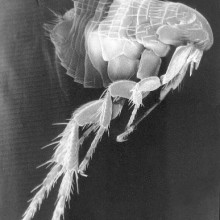
28:31 - Extra-elastic resilin
Extra-elastic resilin
with Chris Elvin, CSIRO Australia
Chris Smith - We're exploring how biology can influence technology and a very springy example is the stuff that keeps the wings of a bumble bee flapping. Joining us from the CSIRO's headquarters, I suppose you could say, in Queensland, Australia: he's here in Cambridge for a meeting. That's Dr Chris Elvin. Hi Chris.
Chris Elvin - Hi, Chris.
Chris Smith - So tell us a bit about this bumble bee's chemical that keeps it wings springy.
Chris Elvin - So this is resilin. This is a protein that's a polymer of amino acids and it's found in probably all insects where it enhances the efficiency of insect flight. It was discovered by a Danish researcher here who became Professor of Zoology here in Cambridge back in the sixties. He did some very elegant experiments to show that this was an almost perfectly elastic material. In other words it loses almost no energy as heat when it's stretched.
 Chris Smith - So you stretch it and let it go and it returns almost all of the energy that you put in.
Chris Smith - So you stretch it and let it go and it returns almost all of the energy that you put in.
Chris Elvin - Exactly. Nearly all of the energy that's put into it is returned: about 97%.
Chris Smith - Chemically, how's that achieved?
Chris Elvin - It's achieved by having an almost completely unstructured random structure for the protein, if you get what I mean. It's cross-linked. There are covalent cross-links between chains of the proteins that allow it to act as a random network polymer which is exactly what you need if you were designing a perfectly elastic polymer.
Chris Smith - How does nature use it?
Chris Elvin - Well, it's as I said. It's present probably in almost all insects that have been looked at. We've certainly looked at it at the gene level in fleas, in dragon flies, butterflies and drosophila. We've pulled those genes out.
Chris Smith - I think mechanically what I'm getting at is we've got wings. How is it attached to the wings? Is it actually intrinsic to the wing material?
Chris Elvin - Well, it's both. It's found in the joins of the wing veins in dragon flies, for example, but it's also found as a major component in a tendon which is attached to the muscles which are attached to the wings. It's that large tendon which Weis-Fogh worked on back in the sixties and poked a tiny little wire, silver wire down through the hole and hung weights off this thing. He showed that when he released the weights it sprang back to exactly the position it was at the start. So it's there on the down stroke when the insect uses its muscles to pull down. This tendon is stretched and then the energy that's stored is released when it comes back up.
Chris Smith - Why is it called resilin? Is that because it's very resilient?
Chris Elvin - It's from the Latin, resilier: to bounce back. He named it resilin.
Chris Smith - Ingenious. Obviously something with those kind of properties would be extremely useful if we could work out how to make this stuff.
Chris Elvin - Absolutely. So we've taken a part of the gene from drosophila and we've published this in Nature back in 2005. We're able to express just part of the gene in E. coli so we turned the E. coli bacteria into little factories. They made the protein. It was a liquid protein solution and we cross-linked it using a photochemical method. We add a catalyst with a photochemical catalyst and an oxidant, we flash it with white light and it turns from a liquid into a rubber. This has the properties of the native material.
Chris Smith - What you're saying is you can steal the gene from the fly, get bacteria to make a sort of precursor form which you're then able to activate. How much can you make?
Chris Elvin - We could theoretically make kilos of it if we wanted to. We've made 100g or more in a large fermenter in CSIRO in Australia. We can then purify that protein using some neat protein chemistry techniques and get it almost pure and then cross-link it with light.
Chris Smith - Say you wanted to make a structure with this. We sold this on this week's show as bad backs. I think the stat you told me a few years ago was a person bends their back 100 million times in their lifetime. A bumble bee flaps its wings 500 million times in a lifetime therefore we think this protein could be used to repair bad backs. Tell us how.
Chris Elvin - We think that's the interesting bit. What you want for a spinal prosthetic disc, because that's what we're talking about, is a number of things. One, you need to have a material with a very high fatigue lifetime. You've mentioned 100,000,000 cycles for the number of times we move out back in our lifetime. This material form a materials point of view has that specification. It can last that long before the bonds break down. What you also want is for the materials not to degrade. This is a protein, it has peptide bonds in it. Proteases will break it up. We need to make it non-proteolitically-sensitive.
Chris Smith - Can you do that?
Chris Elvin - Yes. We have an ARC grant project with Monash University and the plan there is to use non-natural amino acids: beta or d-amino acids which aren't recognised.
Chris Smith - Very clever. So by using things you wouldn't find in the body or nature even they have the same chemical properties but they don't look right. Therefore they can't be broken down by enzymes. Ingenious, then you could cast a disc and put that into someone's back. When would we see this? I've been doing a lot of digging, Chris. My back feels a bit sore. Is this going to be in my lifetime or is this way out there into the future?
Chris Elvin - I think we're probably talking ten years probably. There are some other things that need to be done to it too to make it - it's very soft material. Insects are very small so they don't need stiff springs. It needs to be stiffer and we can do that as well. We've got some ideas to do that.
Chris Smith - Puts a whole new meaning on that movie, The Fly.
Chris Elvin - It does. Thank you for coming to join us. That was Chris Elvin who's a researcher from the CSIRO in Australia. I wish you luck and have a wonderful trip back to Australia. Wonderful country, it's good to have you here in England. That was Chris Elvin from the CSIRO, explaining how you can make the gene product of resilin, this protein that keeps a bee's wings flapping.
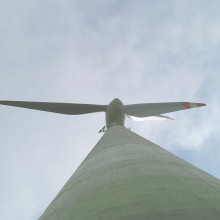
35:27 - Super-renewable bamboo turbines
Super-renewable bamboo turbines
with Jim Platts, University of Cambridge Institute for Manufacturing
Meera talked to Jim Platts of the Univeristy of Cambridge about bamboo in wind turbine blades
Jim - Because wind turbines are a rotating machine but they are in the turbulent boundary layer of the atmosphere they suffer very much from fluctuating loads, the materials which are best for dealing with that are fibre reinforced materials, metals aren't so good. So we can easily think of glass fibre, carbon fibre, or fibre-reinforced composite materials but actually wood is a naturally occurring fibre-reinforced material.
Meera - What makes bamboo more appropriate than other types of wood?
Jim - Many common species of wood have fibres running in lots of different directions, so a block of wood is strong in all directions, but some materials, bamboo is one of them, but you can also think of fir trees, the fibres in the wood are running up the trunk of the tree or up the stem of the bamboo.
Meera - Running in one direction?
Jim - Yes, if they are all running in one direction so you get better properties in that direction
Meera - So why is it more beneficial for a blade to have unidirectional fibres?
Jim - Well a blade is itself rather like a tree. It is fastened at the root end of the blade, and then it is a long cantilevered beam picking up what are heavy aerodynamic loads from the wind, so it is bending the tip of the blade, just like when a tree bends when the wind blows. So you want the fibres running along the blade to give it the tension and compression strength where the beam is bending.
Meera - What actually happens to incorporate wood from bamboo into a wind turbine?
Jim - When we are talking about bamboo we mean Mosa bamboo, which typically grows 12-15m high, the stem is 120mm in diameter and the wall is about 15mm thick, so this is big stuff. What we want is the skin of the bamboo, the outer 1-2mm at the outside of the bamboo which is where the fibres are most densely packed. So that is where we get our highest strength. The rest of the bamboo can be used for furniture or whatever, but this is the really hight tech bit. We then take those strips and stick them one on top of the other to make a plank and then to make the aerodynamic shape and strength of the blade we lie all these planks side by side and end to end to give us the structural strength. Then we cover it with a polythene bag, pump the air out and let resin flow in to stick them all together, which makes one completed structure with a fibreglass skin on the outside to give it a hard surface but all these bamboo strips stuck together inside to give it the technical strength to do the job.
Meera - You actually have some samples of the planks here, put side-by-side covered with resin, and it is very solid, you can't even feel any gaps between the planks
Jim - The resin is doing two jobs, sticking the planks together, but also wood has its best properties when dry so we have dried out the bamboo before we use it, and when the epoxy resin soaks around it the epoxy resin is a complete vapour barrier. A bit like all the chips in the silicon chips in your computer which are encased in epoxy to keep the moisture off them.
Meera - And of course bamboo has a negative carbon footprint
Jim - Yes if we compare bamboo to glass fibre or carbon fibre, we use a lot of energy melting the sand to make the glass to make the fibres, and this energy produces CO2. Because bamboo is a natural product it is actually a carbon sequestration itself. It is taking CO2 from the atmosphere and it is making a high quality structural material out of it. And over the 20 years operating life of the wind turbine it will give you as electricity 400 times the energy content of the bamboo to make the blades. So it has a negative carbon footprint and a huge energy payback.
Meera - So to get a few facts and figures about this then, a typical turbine made of bamboo, what would it look like, how big would it be and how much energy would it produce
JIm - A typical wind turbine is a tower 80-90m high the rotor on the top 80m in diameter, and wind turbine blades 40m long. 3 of those blades on a hub which will produce 1.5MW of electricity. And you would normally have those in a wind farm of 10s or even hundreds of wind turbines making a significant sized power station.
Meera - Where in the world is bamboo going to be used, as it isn't native to the UK?
Jim - There are several major countries with big bamboo resources. The industry is beginning to develop the technology in China.

42:07 - How do sunflowers follow the sun?
How do sunflowers follow the sun?
We asked David Henke, Senior Lecturer in Plant Sciences, at Cambridge University...
It is actually very simple: there is a kind of driver which is growth. If you look at a sunflower there is a narrow neck which is growing, and it is in this narrow neck where most of the cell expansion, and therefore most of the expansion of the stem takes place. And this takes place at different rates on different sides of the stem. So, in the morning, most of this growth is on the West side of the stem so the flower tilts to the East; later on in the day you get stronger and faster growth on the north side, so the flower becomes tilted and so on until the evening when it ends up facing West. At night the growth is corrected and you have a great deal of growth on the West side so at the beginning of the day it is facing East again. This pattern is probably driven by some kind of internal clock, which is set by the transition at the end of the day from light to dark, which then starts the whole process of West side growth in the flower.
We know that the sensitivity of plants to light in terms of the sensors capable of picking up light are quite remarkable, and you can show that the light of a full moon on a completely clear night is just about perceptible to a plant, and the problem is that most of the time the moon isn't full.
Sunflowers do unwind at night using the same alternating growth mechanism as in the day. But what is also interesting is that no one really knows why the flowers themselves follow the Sun. The best guess is that they need more heat to grow more seeds...

Do viruses have a metabolism?
We put this question to Chris Smith...
Chris - This is interesting in terms of biomimetics because people are talking about using viruses and their ability to infect cells and inject their DNA and RNA into cells for gene therapy, so it's an important question...
...And the answer is no. Viruses are not alive they don't have a metabolism, they're nothing more than an infectious bag of genes which is able to put those genes into a cell and make the cell produce all the viral products to make more viruses.
That's all they do.
Does your DNA change through life?
We put this question to Kat Arney.Kat - I could talk about this one for hours but basically yes it does. You pick up mistakes in your DNA as you go through your life due to damage from things like tobacco smoke, from the sun, and just from your own metabolism. That's eventually what causes things like cancer. And also, you get what are called epigenetic changes. These are changes to kind of the code around your DNA. So yes, your DNA is very different when you're older from when you're younger.









Comments
Add a comment